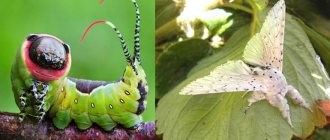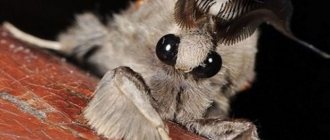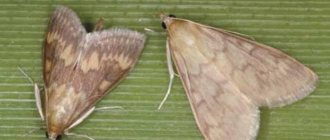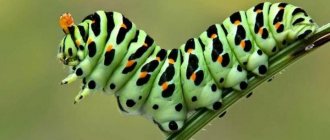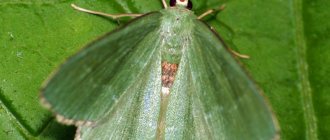Swallowtail (Spicebush Swallowtail)
During development, the caterpillar goes through several color stages - first it is brown with white spots, then it becomes brilliant green, and eventually it becomes orange-red.
The swallowtail butterfly lives in North America.
Transformed good morning with competition)
Good morning!
There seem to be no national holidays today, so I’ll move on to the news.
Scientists have found a way to make roses more fragrant and vibrant
Scientists from France, Germany and China managed to decipher the rose genome and identify the genes that are responsible for aroma and color and the ability to bloom multiple times. The journal Nature Genetics writes about this.
Deciphering the genome in the future will allow experts to make changes to genes and create brighter, longer-lasting roses with a more consistent aroma.
Scientists studied the Rosa chinensis flower (tea or Chinese rose), brought to Europe from East Asia in the 18th century. Using long-sequence DNA sequencing technology, they obtained one of the most complete plant genome sequences ever determined.
It took scientists about ten years to improve the technology. Until now, they have only been able to obtain incomplete, difficult-to-read sequences. The study authors discovered more than 36 thousand genes encoding proteins and biochemical pathways that coordinate the color and smell of a flower.
As the authors note, their work creates the basis for a “new era” in rose breeding.
“When you go to the market and find cut roses, they don’t smell like anything. They smell like plastic,” said Mohammed Bendhman, one of the study leaders. “Hopefully we can change the way these flowers look in the future and make their scent last longer.” The longer they sit in the vase, the less smell there is.”
Source: https://ria.ru/science/20180502/1519764516.html
Spicy food makes the opposite sex more attractive on a first date
Spicy food is probably not something you would think about on a first date. However, new research from scientists at the University of Minnesota shows that dishes with "sparkle" enhance the attractiveness of the opposite sex on a date, increasing the chances of continuing the relationship. According to the findings, women who ate spicy food found men one-fifth more attractive. However, the opposite effect was observed when consuming sweets due to an unconscious association in the brain.
In the test, 87 women were given sweet, savory or neutral snacks and then asked to rate the attractiveness of random men in photographs. It was found that participants who ate spicy foods rated men 21% more attractive than participants who ate sweets. According to experts, these results can be explained by the fact that the spicy taste of food increases the level of physical attraction and romantic interest.
Source: https://kedem.ru/news/2018/05/02/ostraya-eda-povyshaet-privlekatelnost-protivopolozhnogo-pola-na-pervom-svidanii/
Question for today:
What colors are most in your wardrobe?
And now it’s time for the selection. Today it is butterflies and caterpillars.
Butterflies, lepidoptera, whose fossil remains have been known since the Jurassic period, are currently one of the richest species of insect orders - there are more than 158,000 species in the order. Representatives of the order are distributed on all continents, with the exception of Antarctica.
Butterflies go through four stages of development: egg, larva, pupa and adult. It is believed that a butterfly is always superior in beauty to the caterpillar from which it was born.
Let's see if this is true.
Great harpy Cerura Vinula
This is a night butterfly of the Corydalis family. Caterpillar stage: June - September. An adult caterpillar is up to 6 cm in length, green in color. When disturbed, it takes a special threatening pose: it inflates and raises the anterior end of the body, then retracts it into the enlarged first segment of the abdomen.
Butterfly Megalopyge opercularis
They live in deciduous and mixed forests. The caterpillars feed on various broad-leaved trees, such as oak, elm, and citrus.
Butterfly Syssphinx hubbardi
Swallowtail Papilio troilus
Papilio troilus is a North American swallowtail, the closest relative of our swallowtail and swallowtail. The adult is black with iridescence and an elegant pattern of white spots, and the caterpillars are unusually funny: green or yellow with bright false eyes that scare away predators. The caterpillars feed on different types of bay leaves.
Peacock eye Attacus Atlas
The Atlas peacock eye is considered one of the largest butterflies in the world. Wingspan up to 24 cm! In India, this species is cultivated: the caterpillars secrete silk.
Glass butterfly Greta oto
This species is found from Mexico to Argentina, in humid forests. The wingspan of Greta oto is from 5.5 to 6 cm. The tissue between the veins on the wings of the butterfly is transparent because it is devoid of colored scales.
Peacock eye Automeris io
The wingspan of this butterfly ranges from 6 to 9 cm. The female has reddish-brown forewings and legs, while the male has yellow fore and hind wings, body and legs.
Butterfly Morpho
This is a genus of day butterflies from the Nymphalidae family. The color of the wings of most species is blue or light blue, with a metallic sheen. There are species with wings of mother-of-pearl and pearl-white colors; with a black-blue or red-brown pattern. The coloring, shiny with a metallic reflection of the wings, is entirely optical; it is based on the refraction of light.
Another butterfly of the genus True Swallowtails of the Swallowtail family. Found throughout North America, including Canada, the United States and Mexico. This is a large butterfly with a wingspan of 8-11 cm. The upper side of the wings is mostly black. Caterpillars in the first phases of development (up to 1.5 cm in length) are black with a white stripe in the middle, with white bristles having a light brown ring at the base.
Hyalophora cecropia
The largest moth in North America and one of the most brightly colored. Usually, at the end of autumn, after four molts, cecropia caterpillars, which have managed to grow to 10-12 cm, wrap themselves in a cocoon. They pupate in it, spend the entire winter and are born in the first warm days of summer.
Cabbage butterfly Pieris brassicae
The caterpillar is up to 3.5 cm long, 16-legged, greenish-yellow, dotted with sparse and short black hairs and black dots; along the back and on the sides, above the legs, 3 yellow stripes stand out; the head and the last segment of the body are gray on top with black dots.
When you click, it will turn into a butterfly that loves cabbage leaves.
Madagascar comet Argema mittrei
This is a very large moth from the peacock-eye family (Saturniidae). The image of a butterfly is present on the 5,000 Malagasy francs (ariary) banknote (currency of the state of Madagascar), model 1995. The wingspan is 140-180 mm.
Maack's swallowtail Papilio maackii
The largest diurnal butterfly in Russia. The specific name is given in honor of Richard Karlovich Maack, a Russian naturalist, explorer of Siberia and the Far East. The female is larger than the male, her wingspan is up to 135 mm, in the male - up to 125 mm.
Found it here.
I suggest you come up with a cool name for this photo:
Have a wonderful day! Magic! Beautiful! Bright!
News from Sakhalin and the Kuril Islands on WhatsApp - constantly throughout the day.
Subscribe with one click!
If you have a topic, write to us on WhatsApp: +7-962-125-15-15
Moth (Acharia Stimulea)
The caterpillars are green-white-brown in color, and are painted so that it looks like they are wearing a saddle and blanket or blanket. The caterpillars have a pair of fleshy horns topped with hairs that secrete an irritating poison.
Butterfly of the slug family.
About the appearance of peacock eyes
A pair of Chinese oak peacock-eyes on a cocoon pupa.
Depending on the species, these insects can be either very small or simply “giant” in size. For example, the small peacock eye has a wingspan of no more than 8 centimeters.
Antennae of the peacock mimosa (Argema mimosae).
As for the large representatives of the family, which inhabit mainly tropical zones, their wings reach a span of even 27 centimeters! The average size of the wings of peacock eyes in the unfolded state ranges from 12 to 15 centimeters.
Selenium peacock eye (Astias selene).
In appearance, the body of the peacock eye resembles ordinary night moths: it is covered with villi that form a thick fluff. The wings have a fairly simple shape.
The Sikkimese Lepa (Loepa sikkima) is one of the few brightly colored peacock-eyes.
The color of peacock eyes is often modest, inconspicuous and even camouflage. Nature came up with this for a reason, because members of the family are nocturnal creatures. However, there are also species whose wings have bright shades or bright patterns.
Slug worm (Isochaetes beutenmuelleri)
Dozens of sparkling needles, as if covered with frost, decorate the body of this caterpillar, giving it an elegant, almost fairy-tale appearance.
Woodlice butterflies live in North America, from the states of New York and Florida to Colorado and Texas.
Where do peacock eyes live?
These arthropods inhabit the entire globe, with the exception of Antarctica. They can be found in East Asia (where they reached maximum species diversity), Europe, and America.
Pear peacock eye, or large night peacock eye (Saturnia pyri).
Peacock-eyes prefer to live in broad-leaved and mixed forests. In addition, they are found in mountainous areas and meadows, but only where there are trees nearby. “Tree dependence” in peacock-eyes is not at all accidental, because the females of these butterflies spend most of their lives in the crown of the tree, very rarely leaving their “home.”
Nutrition and lifestyle
Butterflies are very thermophilic and live in the southern regions. They fly from April to June in the evening twilight and at night. Despite its size, the insect is very short-lived, its average lifespan is from 4-5 days to 2 weeks. During this time, butterflies do not feed at all; their main goal is procreation. Females are inactive, often sitting on branches and tree trunks waiting for males, emitting pheromones to attract them. Males, on the contrary, fly a lot in search of a partner. In the dark, they can even be mistaken for a small bird or bat. In the 19th century, entomologist Jean Henri Fabre found that a male Saturnia pear can detect a female more than 10 km away. The pear peacock eye is listed in the Red Book of individual states and regions as a rare species, the number of which is insignificant.

